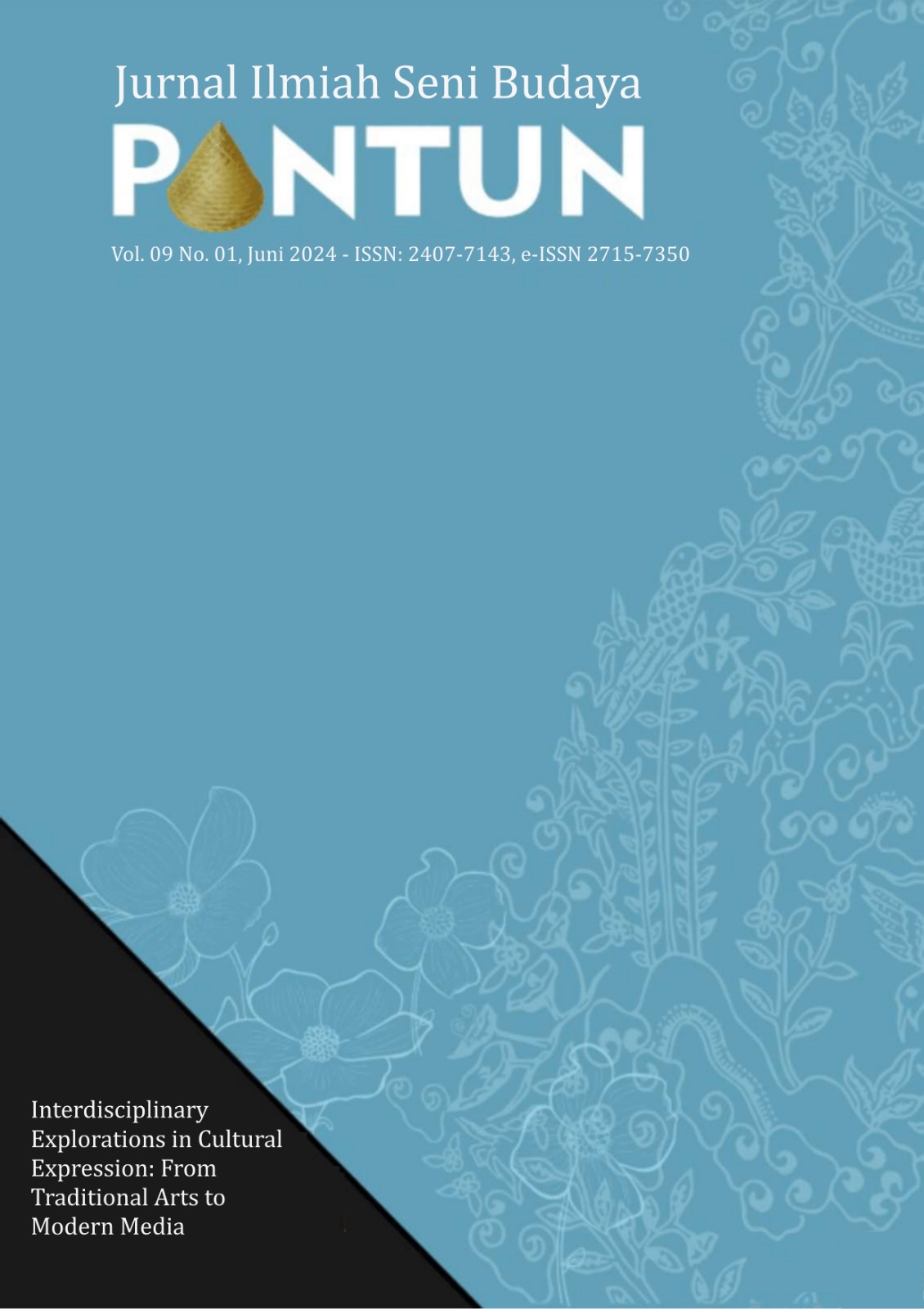Visual Contemporary Painting Based on The Visual Appropriation of Abhimanyu’s Death
DOI:
https://doi.org/10.26742/pantun.v9i2.3470Keywords:
Appropriation, Abhimanyu, Contemporary, JuxtapositionAbstract
The concept of visual appropriation involves using elements borrowed from others to create a work of art. In this research, appropriation entails utilizing images and narrative context from various sources to depict Abhimanyu’s death on the 13th day of the Bharatayuda war. This article explains the method for creating the visual appropriation of Abhimanyu. The process of creating visual appropriation is based on exploring, designing, and realizing craft arts, incorporating digital sketching, manipulation, media and technique discovery, imprimatura, collage, cropping, coloring, and finishing. The creation process involves identifying visual forms and their relationship to current phenomena and adding new meanings that alter the original context. The aim of creating contemporary painting is to make young people aware of the challenges or obstacles of the current situation and the need to develop strategies to deal with them. Resulting works aim to juxtapose visual references to provoke thought and reinterpretation of their meaning for the audience.
References
Abdurrahman, D. I. (2018). Apropriasi Transkultural Pada Konfigurasi Karakter Son Goku Dalam Manga Dragon Ball. Idealogy Journal, 3(2), 3-10.
Adnyana, I Wayan. (2015). Arena Seni Pita Maha: Ruang Sosial dan Estetika Seni Lukis Bali 1930‘an. Panggung, 25 (3), 249-263. https://doi.org/10.26742/panggung.v25i3.22
Adnyana, I. W., Remawa, A. R., & Sari, N. L. D. I. D. (2018). Multinarasi relief yeh pulu basis penciptaan seni lukis kontemporer. Mudra Jurnal Seni Budaya, 33(2), 249- 255. https://doi.org/10.31091/mudra.v33i2.372
Afrough, M, (2024). The Approach of Appropriation Art in a Selection of Visual Examples of Hand-Woven Iranian Carpets. Kimiya-ye-Honar, 13(50), 99-121. 10.22034/13.50.99
Alfiyah, R. (2024). Kajian Tekstologi Lakon Wayang Abimanyu Gugur Via Youtube Kedatangan Abimanyu ke Peperangan-Gugurnya Sumitra. CaLLs (Journal of Culture, Arts, Literature, and Linguistics), 10(1), 152-169. http://dx.doi.org/10.30872/calls.v10i1.13558.
Alsah, S., Akbar, S. M., & Patriansah, M. (2024). Studi Kasus Pelanggaran Kode Etik Dalam Desain Komunikasi Visual. VisArt: Jurnal Seni Rupa dan Design, 2(1), 88-99.
Ariyanti, A., & Astawan, I. K. Y. (2023). POTRAIT OF GRIET: Sebuah Kajian Seni Lukis Apropriasi Karya Dadang Rukmana. Imajinasi: Jurnal Seni, 17(2), 21-28.
Cattien, J., & Stopford, R. J. (2023). The appropriating subject: Cultural appreciation, property, and entitlement. Philosophy & Social Criticism, 49 (9), 1-18. https://doi.org/10.1177/0191453721105951
Effendy, Rifky. (2007). Pengantar Kuratorial, Dalam Apropriasi Spektrum Praktek Apropriasi Dalam Seni Rupa Kontemporer Di Indonesia. Indonesian Visual Art Archive.
Fauzi, E. P., & Prasetyo, K. (2023). Pemaknaan Apropriasi Budaya Pada Video Make A Wish. Jurnal Komunikasi Global, 12(1), 98-121. https://doi.org/10.24815/jkg.v12i1.28489
Gustami SP. (2007). Butir-butir mutiara estetika timur: ide dasar penciptaan seni kriya Indonesia. Prasista, Yogyakarta.
Hidayatullah, Ari Dhika. (2021). Respon Dan Peran Generasi Muda Dalam Agenda Perubahan Iklim. Sosio Religia, 2 (1).
Himawan, Willy & Nugroho, Budi. (2014). Visual Tradisi dalam Karya Seni Lukis Kontemporer Sebagai Wujud Artistik Pengaruh Sosial Budaya. Journal of Urban Society's Arts, 1(4), 99-109. https://doi.org/10.24821/jousa.v1i2.791
Jameson, F. (1998). Postmodernism and Consumer Society. Selected Writings on the Postmodern 1983-1998. Verso, London.
Mix, E. K. (2015). Appropriation and the Art of the Copy. Choice, 52(9), 1433-1445.
Patriansah, M., Prasetya, D., & Aravik, H. (2021). Kegiatan lomba mendongeng sebagai pembentukan karakter siswa sekolah dasar di kota palembang. SELAPARANG Jurnal Pengabdian Masyarakat Berkemajuan , 5 , 149–156. https://doi.org/10.31764/jpmb.v5i1.4881
Purwita, Dewa Gede. (2019). Ngedum Karang, Jajar Wayang, Ceraki Membedah Kerja Desain Pada Seni Lukis Wayang Kamasan. SENADA, 2, 209-215.
Sitindjak, R. H. I. (2020). Apropriasi Rumah Tradisional Batak Toba pada Arsitektur Gereja Katolik Pangururan di Samosir. Biokultur, 9(2), 87-100. https://doi.org/10.20473/bk.v9i2.23118
Sudirana, I Wayan. (2019). Tradisi Versus Modern: Diskursus Pemahaman Istilah Tradisi dan Modern di Indonesia. Mudra Jurnal Seni Budaya, 34 (1), 127-135.https://doi.org/10.31091/mudra.v34i1.647
Wibowo, C. P., Ahmad, A. S. E., & Ds, M. (2019). Apropriasi Karakter Plastic Man Dalam Penciptaan Karya Seni Lukis. Jurnal Seni Rupa, 7 (3), 118 - 125.
Downloads
Published
Issue
Section
Citation Check
License
The Authors submitting a manuscript do so on the understanding that if accepted for publication, copyright of the article shall be assigned to Pantun: Jurnal Ilmiah Seni Budaya and Pascasarjana ISBI Bandung as the publisher of the journal. Copyright encompasses rights to reproduce and deliver the article in all form and media, including reprints, photographs, microfilms, and any other similar reproductions, as well as translations.
Pantun: Jurnal Ilmiah Seni Budaya and Pascasarjana ISBI Bandung and the Editors make every effort to ensure that no wrong or misleading data, opinions or statements be published in the journal. In any way, the contents of the articles and advertisements published in Pantun: Jurnal Ilmiah Seni Budaya are the sole and exclusive responsibility of their respective authors and advertisers.
The Copyright Transfer Form can be downloaded here: [……………..) The copyright form should be signed originally and send to the Editorial Office in the form of original mail, scanned document or fax :
Dr. Jaeni, S.Sn., M.Si. (Editor-in-Chief)
Editorial Office of Jurnal Pantun
Program Pascasarjana ISBI Bandung
Jl. Buah Batu 212 Bandung
Telp./fax +62-22-730532/+62-22-7303021
Email : jurnalpantun@isbi.ac.id









